3 Ways New York Must Advance Reproductive Rights This Year
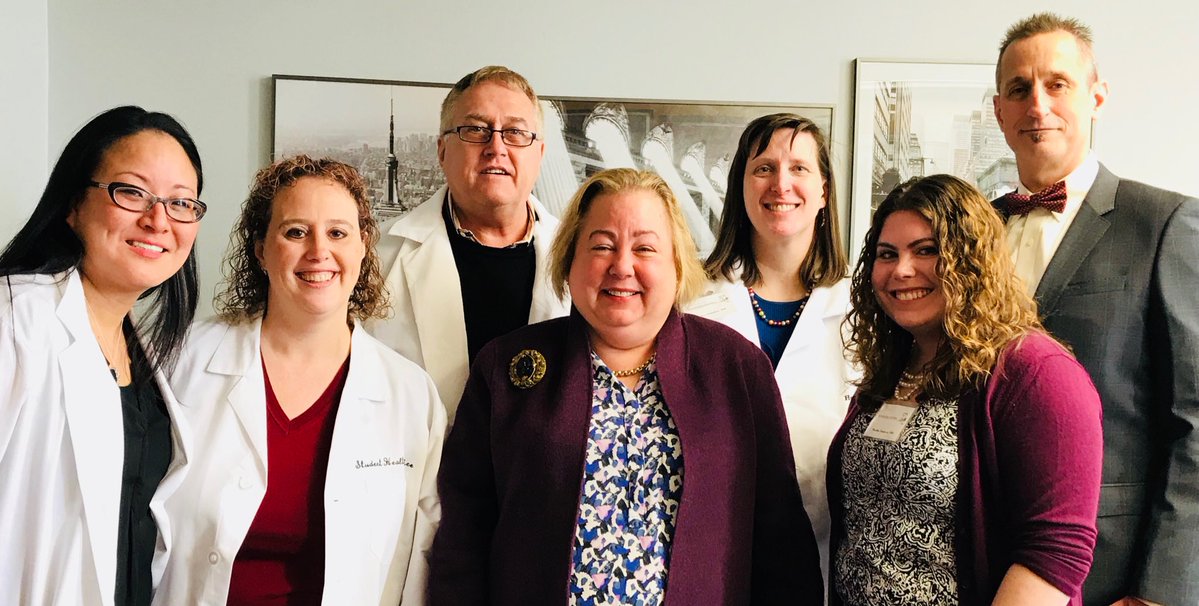
Senator Krueger, the author, with doctors (photo: @jmumfordmd)
Note: this column was written and published in March, 2018, several months before Democrats won control of the state Senate through the November elections; they will take the majority in January
On March 13, the New York State Assembly passed three critical bills regarding reproductive health and rights: the Reproductive Health Act (RHA), the “Boss Bill,” and the Comprehensive Contraception Coverage Act (CCCA). Unfortunately, the majority coalition in the State Senate continues to bottle these bills up in committee, as it has for years, preventing them from getting an up-or-down vote on the Senate floor. This obstruction simply cannot continue.
New Yorkers deserve modern laws to protect their deeply personal decisions about reproductive healthcare, and the time to act is now.
Why the urgency, you may ask, when New York is seen as a leader in protecting women’s reproductive rights, and Roe v. Wade continues to be the law of the land?
The simple answer is that there is a war on women’s reproductive rights in our country at the state and federal level, and it has significantly intensified during the Trump Administration. Conservative judges are being appointed to state and federal courts; funding is being redirected from Planned Parenthood to clinics that do not perform abortions, and from evidence-based sex education and pregnancy prevention programs to ineffective abstinence-only programs; laws and regulations seek to chip away at Roe v. Wade and restrict abortion access by creating unnecessary hurdles and criminalizing pregnancy; lack of coverage, high co-pays, and harmful regulations reduce access to contraception.
Even in New York, our reproductive health and rights are at risk because of our outdated and unconstitutional laws.
If a pregnant woman becomes critically ill after 20 weeks, or learns that the fetus is not viable, she must choose among terrible options: travel out of state to get an abortion (if her family can afford the hefty expense); carry to term and risk a dangerous labor to deliver a baby that is stillborn or able to survive only briefly, often in great pain; or possibly face criminal charges for getting the abortion in New York.
Current state law also fails to protect women and men from being fired or otherwise discriminated against by their employer for their reproductive healthcare decisions, whether making the decision to get an abortion, or simply choosing to use contraception. In addition, although access to contraceptive options is instrumental in reducing the number of unintended pregnancies, including teen pregnancies, and leads to families that are planned, safe, and healthy, many New Yorkers face barriers to contraceptive services due to lack of financial resources.
The RHA, the Boss Bill, and the CCCA address these pressing issues.
The existing New York State abortion law was enacted in 1970. It is not based on modern medical practices, and it does not guarantee the same constitutional protections as Roe v. Wade. Passing the Reproductive Health Act (S2796/A1748) would provide for abortion care after 20 weeks if a woman’s life or health is at risk, or if a fetus is not viable. Additionally, the RHA repeals outdated and unconstitutional criminal statutes banning abortion, and moves the regulation of abortion into the public health law, where it belongs, ensuring that New York State law treats abortion as health care and not a criminal act. Reproductive health care decisions should be made by a woman and her doctor – not by politicians or the government.
The Boss Bill (S3791/A566) closes a gap in current workplace anti-discrimination laws. Employees would not need to fear being the target of employer discrimination if they use contraception, get abortion care, or seek other reproductive health services.
The Comprehensive Contraception Coverage Act (S3668/A1378) requires insurance policies to provide coverage for all FDA-approved contraceptive products. Policies are also required to cover emergency contraception, voluntary sterilization procedures, patient education and counseling on contraception, follow-up services, and the provision of a 12-month supply of a contraceptive at one time, without a deductible, co-payment, or any other cost-sharing requirement.
At this critical time when women’s health and reproductive rights are under attack, New York must demonstrate bold leadership and stand up for women’s equality and healthy families. I urge my fellow New Yorkers to hold your Senators accountable. New York families have waited long enough - we can and must pass these bills.
***
Liz Krueger is a state senator representing parts of Manhattan. On Twitter @LizKrueger.
***
Have an op-ed idea or submission for Gotham Gazette? Email This email address is being protected from spambots. You need JavaScript enabled to view it.
Bridge Programs Get Big Results, But Little Support
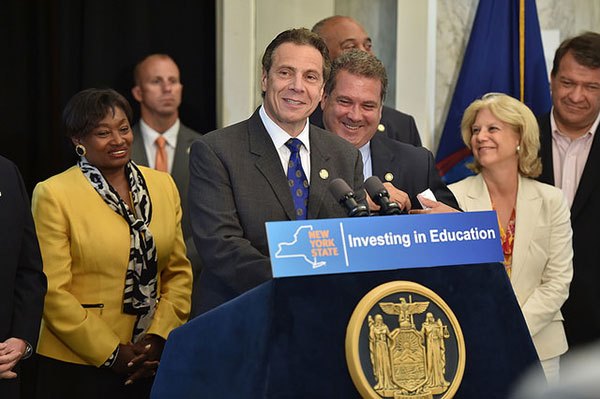
(Photo: Office of the Governor - Kevin P. Coughlin)
Governor Cuomo’s $175 million workforce development proposal, announced earlier this year, promises major new investments in the skills-building programs that New York needs. With industries like healthcare, tech, and construction facing shortages of skilled workers, the governor’s plan can help expand access to opportunity while boosting the economy.
But for millions of New Yorkers who lack math and literacy skills—including 2 million adults without a high school diploma and 2.3 million who speak English less than very well—gaining entry to effective workforce programs will first require boosting their basic skills. That is the idea behind bridge programs, which help adults with limited formal education acquire the skills they need to transition into training and higher education.
Given the enormous population of New Yorkers with these needs, expanding bridge programs should be part of any statewide workforce development proposal. Ideally, these programs can teach adult basic education in the context of an industry, while building momentum toward a marketable credential. However, fewer than a dozen programs in New York City and just a handful upstate put the full bridge model into practice.
It’s time to change this. New York State should make investing in bridge programs part of its workforce development plan.
Where the model has been implemented, the results are impressive. Bridge programs work for people with limited opportunities and no time to waste. Research has found that bridge programs are effective for students with significant barriers to employment, including those with a reading level as low as the 7th grade.
New York’s leading example is the Bridge to College and Careers program at LaGuardia Community College. Through coursework that focuses on healthcare, science, or business, the program provides meaningful context for the math and literacy skills students need to pass their high school equivalency exams.
LaGuardia’s bridge program has connected with especially vulnerable demographics: About half of its bridge students are 26 or older, almost half are immigrants, and over 50 percent read at a 7th or 8th grade level. Many of these students are balancing commitments that make going back to school particularly difficult, such as multiple part-time jobs and children at home.
A 2013 study by MDRC showed that students in LaGuardia’s bridge program were twice as likely as their peers to pass the high school equivalency exam and three times as likely to pursue a postsecondary degree. The program has proven so effective that other states are using it as a model, notably a new bridge program at Northeast Wisconsin College. But even as Wisconsin imports LaGuardia’s pioneering program, none of New York State’s 35 other community colleges have been funded to offer bridge programs of their own.
Aside from the program at LaGuardia Community College, most of New York City’s bridge programs are run by nonprofit job training and adult education providers. One notable example is Per Scholas, a respected Bronx-based training organization, which partnered with The Door to create a five-week TechBridge program where participants catch up on basic math and English skills before transitioning to Per Scholas’ IT Support job training course.
The landscape of bridge programs is even more limited upstate. One bright spot is CenterState CEO, a business development organization in Syracuse, which integrates math and literacy education into a green construction training program. Likewise, the New York Association for Continuing and Community Education offers adult basic education that bridges into a certified nurse’s assistant training program. Other initiatives organized by community colleges, nonprofits, and intermediaries only use elements of the bridge model—like combining adult literacy programs with pre-college preparation—and are hampered by limited resources and a lack of coordination with industry partners.
Multiplying the capacity of bridge programs will require state leadership. Governor Cuomo and the state Legislature should fund pilot projects at community colleges statewide modeled on LaGuardia’s successful initiative, provide resources to scale up proven programs run by nonprofit providers, and invest in the capacity of business development intermediaries to bring stakeholders together to create bridge programs.
The new state Office of Workforce Development can also organize partnerships among schools, nonprofits, and employers to shape bridge programs that work for the needs of specific regions. As bridge initiatives grow, New York should prioritize programs that implement the full model—offering adult education in an industry context, bridging into a program that offers a postsecondary or industry-recognized credential, and incorporating a credential into the bridge program itself.
New York’s bridge programs serve nowhere near the number of adults who would benefit from them. It’s time for New York to catch up. Building support for the bridge model into the state’s bold new workforce investment plan can help ensure that a shot at economic mobility is accessible to all.
***
Naomi Sharp is a research associate at the Center for an Urban Future, a New York–based think tank focused on expanding economic opportunity. On Twitter @nycfuture.
***
Have an op-ed idea or submission for Gotham Gazette? Email This email address is being protected from spambots. You need JavaScript enabled to view it.
Segregation is Not an Excuse, Mr. Mayor; It’s Opportunity to Lead
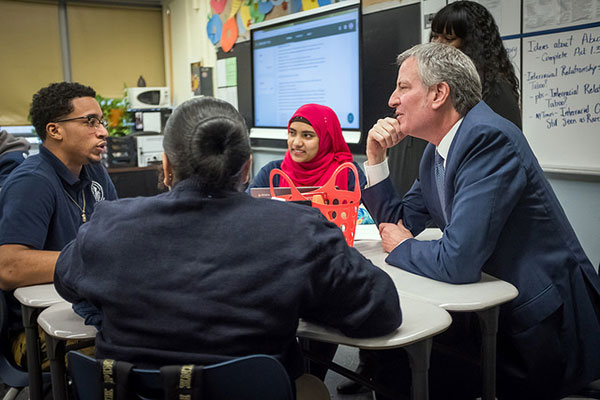
(Photo via Ed Reed/Mayor's Office)
Curbed NY recently reported that the vast majority of the affordable-housing units created under Mayor Bill de Blasio’s Housing New York plan are unaffordable to large swaths of the population. The ironic response from New York City’s Department of Housing Preservation and Development (HPD) was that the policy promotes “diverse and integrated neighborhoods.”
This explanation is puzzling, to say the least, for integration advocates. The phrase “integrated neighborhoods” does not appear once in the mayor’s 117-page housing plan, and there is only a single reference to “fair housing.” “Diverse neighborhood” does appear frequently, but only to signify “affordable to more than one income group” - rather than a larger goal of opening neighborhoods where more resources and opportunities are clustered and where few affordable housing units exist.
The administration’s actions speak even louder than its words. Inclusionary housing - as its name suggests - should provide historically excluded populations with expanded housing choices including access to “higher opportunity” neighborhoods. The de Blasio administration flipped this concept on its head with its mandatory inclusionary housing regime - primarily targeting some of the poorest neighborhoods of color for “affordable” housing development with limited opportunities for the lowest-income populations to participate, putting them at considerable risk of displacement and homelessness.
The new law does not even include reasonable guidelines to ensure that affordable housing is built in areas that offer greater educational opportunity. The administration is fighting a lawsuit which seeks to eliminate the City’s outsider-restriction (or “community preference”) policy that appears to violate the Fair Housing Act. Most recently, both HPD and the Human Rights Commission came out to testify against a modest piece of legislation that would have placed reasonable restrictions on housing co-ops to reduce illegal housing discrimination.
For school-integration advocates, this all feels familiar. In 2015, even as Chancellor Carmen Farina repeatedly dismissed the need for proactive school-integration policies, Deputy Mayor Richard Buery actively touted the benefits of classroom diversity to justify the universality of universal pre-K. (Fortunately, towards the end of her tenure the chancellor started to bend and took some important steps forward.)
For fair housing advocates, the City’s actions fail to affirmatively further fair housing and merely continue a long history of actions by government and private real estate interests that effectively reinforce patterns of poverty concentration and residential racial segregation and fuel a vicious cycle of inequality.
The administration invokes diversity and integration when convenient, while largely ignoring the pleas and policy prescriptions of school- and housing-integration experts. Occasionally, the strategy can feel divisive - creating a false opposition between the goals of caring for our most vulnerable citizens and dismantling the structures that produce and sustain racism, poverty, and inequality. At its worst, the strategy suggests that “diversity” is mere cover for an unfettered pro-development agenda that protects the interests of developers and many of the more affluent and predominantly white neighborhoods in the city. In any event, we see too many current school and housing policies as reinforcing the “tale of two cities” that the mayor himself campaigned against.
Continuing residential segregation by race and income is a condition that nourishes a host of inequalities including gentrification. We believe policies that produce meaningful integration in schools and housing are the best antidote to gentrification. As the federal government signals a clear retreat from enforcing the 50-year-old Fair Housing Act, we need local leadership on these issues now more than ever.
As historic demographic changes threaten to transform every aspect of New York City, we urge the mayor to begin exercising real leadership - for New York City and for metro areas across the nation. The integration of our communities is neither a political liability to be ducked, nor a convenient excuse to be exploited; it is an opportunity to lead. Our organizations stand ready to assist and support all efforts to create schools and neighborhoods that are inclusive and equally open to all New Yorkers.
***
Fred Freiberg is executive director of the Fair Housing Justice Center. David Tipson is executive director of New York Appleseed. On Twitter @FredFreiberg of @fairhousingnyc and @AppleseedNY.
***
Have an op-ed idea or submission for Gotham Gazette? Email This email address is being protected from spambots. You need JavaScript enabled to view it.
GothamTalks: What To Do If You're A Gentrifier

Gotham Gazette and New Leaders Council -- a nonpartisan, nonprofit leadership institute -- have partnered with Manhattan Neighborhood Network to create a series of video commentaries by New York City civic activists. GothamTalks is short video essays submitted through the New Leaders Council alumni network, which consists of hundreds of New Yorkers working in advocacy, government, campaigns, nonprofits, business, law, and other aspects of city life.
Like both the reporting we do at Gotham Gazette and the written op-ed columns we publish, the GothamTalks video commentaries range in subject, but are all meant to move the public discussion forward. Please watch, listen, and let us know what you think. Use #GothamTalks on social media, and tag us @GothamGazette and @NLC_NYC.
Note: The views expressed in GothamTalks are entirely those of the commentators, and not of Gotham Gazette or New Leaders Council.
************
March 14, 2018
Jordan Stockdale
Gentrification, and What To Do If You're a Gentrifier
GothamTalks: Campaign Finance Reform Now

Gotham Gazette and New Leaders Council -- a nonpartisan, nonprofit leadership institute -- have partnered with Manhattan Neighborhood Network to create a series of video commentaries by New York City civic activists. GothamTalks is short video essays submitted through the New Leaders Council alumni network, which consists of hundreds of New Yorkers working in advocacy, government, campaigns, nonprofits, business, law, and other aspects of city life.
Like both the reporting we do at Gotham Gazette and the written op-ed columns we publish, the GothamTalks video commentaries range in subject, but are all meant to move the public discussion forward. Please watch, listen, and let us know what you think. Use #GothamTalks on social media, and tag us @GothamGazette and @NLC_NYC.
Note: The views expressed in GothamTalks are entirely those of the commentators, and not of Gotham Gazette or New Leaders Council.
************
March 12, 2018
Michael Pernick
Campaign Finance Reform
Sunlight for Subsidies
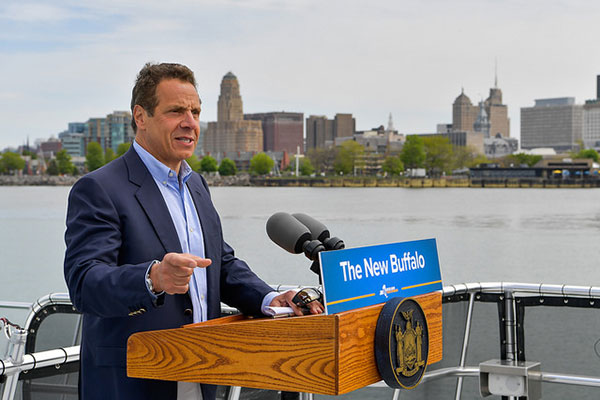
Gov. Cuomo in Buffalo (photo via The Governor's Office)
New York State and local governments spend over $8 billion annually in taxpayer money, giving subsidies to businesses through tax abatements and credits, low or no interest loans, grants, and capital investments like building factories. Eight billion dollars could otherwise pay for the MTA Subway Action Plan in addition to the entire 5-year capital plan for New York City Housing Authority (NYCHA). Instead it is awarded to wealthy companies like Alcoa, IBM, Goldman Sachs, Tesla, Verizon and JP Morgan Chase.
While spending billions, Governor Cuomo and Empire State Development have not acted on common-sense transparency measures that provide basic information taxpayers deserve to know: the types of benefits companies are receiving; the cost to taxpayers; and the number and cost of jobs created or retained.
Their inaction comes as the governor’s former senior advisor Joe Percoco was convicted on three federal corruption counts, including solicitation of bribes, in the first of two trials involving the alleged rigging of contracts tied to upstate mega-development projects worth hundreds of millions of dollars in business subsidies.
New Yorkers deserve to know more about economic development money being spent, including where it is going and what the money is actually producing.
Democratic Assemblymember Robin Schimminger and Republic Senator Tom Croci have introduced legislation (A.8175/S.6613-B), which would create a “Database of Deals” listing all projects awarded to a particular company, detailing subsidies received, and what New Yorkers are receiving for their return on investment in the taxpayer cost per job. The bill passed out of committees in both houses last year but never made it to the floor for a vote.
The Assembly and Senate each included a similar proposal in one-house budget resolutions passed on Wednesday. Meanwhile, the New York City Council passed legislation in December codifying its own “Database of Deals” established by the city’s Economic Development Corporation (EDC.) EDC had already made economic development in New York City more transparent by publishing a map showing major projects and their essential data across the five boroughs.
A state “Database of Deals” is fundamental transparency modeled on existing disclosure in numerous states of different political stripes including Florida, Maryland and Indiana. This reflects the near-unanimity on the need for greater transparency and accountability of business subsidies.
While states fervently compete to give taxpayer subsidies to the world’s wealthiest corporation, Amazon, for its second headquarters, the way in which public money is awarded is being challenged from the left and the right. Nationally, the progressive labor-backed Good Jobs First has long advocated for economic development accountability while the conservative Koch Foundation is seeking proposals to “identify and develop measures to provide transparency and accountability to corporate welfare.” In New York, groups as ideologically varied as the Working Families Party, Citizens Budget Commission, and Empire Center have questioned the state’s economic development practices.
But Governor Cuomo need look no further than his own 2013 Tax Reform and Fairness Commission to understand the need for transparency and accountability of business subsidies. In a report written for the commission entitled New York State Business Tax Credits: Analysis and Evaluation, the authors concluded, “There is, however, no conclusive evidence from research studies conducted since the mid-1950s to show that business tax incentives have an impact on net economic gains to the states above and beyond the level that would have been attained absent the incentives. In addition, business tax incentives violate principles of good tax policy and tenets of good budgeting.”
Despite the questioning of their efficacy, Governor Cuomo’s Executive Budget proposes over $2 billion in new spending and tax credits on business subsidies. Last year, the Assembly and Senate wrote the governor a blank check, increasing economic development spending without passing any legislation that would make the spending more transparent or measure the effectiveness of whether, and which, business subsidies work best.
This year, Reinvent Albany and fiscal and transparency watchdog groups are urging the governor and Legislature to act on four measures to make taxpayer spending on business subsidies more transparent and accountable, including the “Database of Deals.”
They should act swiftly to restore the public trust, which has been battered by federal indictments and sordid accounts of insider dealing at trial.
***
Alex Camarda is senior policy advisor for Reinvent Albany. On Twitter @alex_camarda and @ReinventAlbany.
***
Have an op-ed idea or submission for Gotham Gazette? Email This email address is being protected from spambots. You need JavaScript enabled to view it.
Don’t Let Congestion Pricing Push Accessible Taxis Off the Road
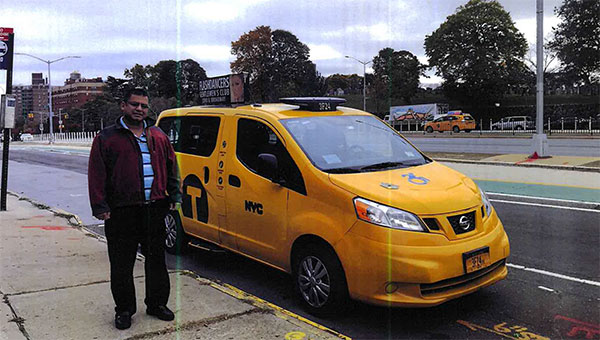
Masud Chowdhury, the author
As a longtime yellow taxi driver, I was proud to be among the first to drive one of the city’s wheelchair-accessible taxis, which are equipped to serve New Yorkers with disabilities. There are now around 2,000 accessible yellow taxis in New York City as the industry continues striving to become 50 percent accessible by 2020.
But it might be impossible for taxi drivers like me to keep our accessible vehicles on the road if we are hit with high fees under a congestion pricing system designed to raise funds for mass transit repairs. While the concept of congestion pricing is a good thing and more money must be generated for our subway system, the fact is that it would be unfair to target yellow taxis under such a program.
The problem here is that state officials are in the process of considering potential congestion pricing plans that would treat taxis in the same way as app-based ride-hailing companies like Uber and Lyft. Although that might sound fair, in reality it is not fair at all.
Yellow taxis have already contributed hundreds of millions of dollars to our subways and mass transit infrastructure, as well as providing an important source of accessible transportation. Uber and Lyft, both multi-billion-dollar companies, have done neither of these things – and any congestion pricing plan must hold these companies accountable without harming hardworking taxi drivers who are already doing the right thing.
New Yorkers must remember that, since 2009, yellow taxis have been paying a 50-cent fee to the MTA on every single ride, generating significant revenue for mass transit. Uber and Lyft have refused to follow suit and instead pay sales tax, which does not provide nearly as much support to the subway system. In fact, MTA officials have acknowledged in the past that the rapid growth of app-based companies has deprived the state of funding that could have gone to support mass transit infrastructure.
At the same time, while cabbies like me have put a great deal of effort into driving accessible taxis that are much costlier and more difficult to maintain, Uber and Lyft have done nothing to put their own accessible cars on the road. We are already bearing a heavy burden to provide this important service to thousands of wheelchair users – and these billionaire companies are not.
And let’s be real – we all know these companies have been the much bigger driver of added congestion in New York City. Since 2013, the number of vehicles for Uber, Lyft and other similar companies has nearly doubled from 47,000 to more than 100,000 in 2017, while the yellow taxi industry remains capped at roughly 13,500 medallions.
When you look at all the facts, there is simply no reason for state officials to even consider a congestion pricing plan that would treat taxi drivers like me the same as companies like Uber and Lyft. It wouldn’t just be unfair – it could make it even harder to keep costly accessible taxis on the road, and that would be a problem not just for me but for so many New Yorkers with disabilities.
On behalf of other drivers feeling the same concerns, I sincerely hope that Governor Cuomo and the state Legislature will keep these important issues in mind and develop a congestion pricing framework that is fair to everyone on the road – including yellow taxis.
***
Masud Chowdhury drives a wheelchair accessible taxi. A yellow taxi driver for more than 20 years, he lives with his family in Ozone Park, Queens.
***
Have an op-ed idea or submission for Gotham Gazette? Email This email address is being protected from spambots. You need JavaScript enabled to view it.
Offshore Wind, Onshore Justice
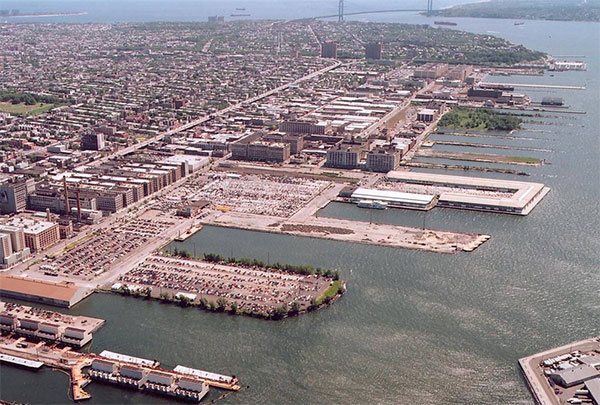
the Sunset Park waterfront
In New York City, we have learned from hard experience that our energy, environmental, and economic systems are highly interrelated. Decades of underinvestment in low-income communities of color – particularly from the loss of blue-collar industries -- compounds the profound vulnerability of these neighborhoods to climate change.
Beyond New York, 2017 saw ten consecutive Atlantic hurricanes, a historical first: Irma was the strongest storm to reach beyond the Caribbean; Harvey brought the greatest rainfall; and months after Maria wrought unprecedented devastation, half of Puerto Rico is still in the dark. For both the Global South and South Brooklyn, the time for incremental solutions has passed. We need an immediate and just transition towards a regenerative economy.
At UPROSE, a community-based organization in Sunset Park that advocates for sustainable economic development and environmental justice, our advocacy for climate justice is rooted in our struggles against displacement—displacement by rising waters and rising costs of living. The Climate Justice Alliance is a national collaborative of over 50 community-based and support organizations working to forge a scalable, and socio-economically just transition away from an extractive economy and towards local living economies.
Together, we are calling for the creation of new offshore wind manufacturing and logistics jobs on New York City’s waterfront to strengthen neighborhood resilience and make the case against re-zonings that irreversibly impair our capacity to address climate change locally.
Sunset Park is home to one of the city’s last working waterfronts and is today the target of rampant commercial speculation. Offshore wind energy can address the neighborhood’s vulnerabilities by saving maritime industrial sites, displacing dirty fossil-fuel plants that disproportionately affect people of color, and creating thousands of local jobs. The Department of Energy expects 40,000 such jobs by 2030 – and those opportunities will accrue wherever the ports and workforce are.
Positioning New York City at the center of this industry would localize supply chains and capture jobs for a fast-growing regional market. By 2020, our waterfront could see the first wave of opportunities: welding and turbine final assembly jobs, all under the banner of organized labor. Significant benefits to ancillary businesses could prioritize M/WBEs and lift local economies.
To advance this vision, Mayor de Blasio can take three actions.
First, the City can leverage its purchasing power to catalyze offshore wind construction. Second, the City can prioritize offshore wind uses at its waterfront industrial sites. Third, it can partner with local groups like UPROSE, labor, industry, and CUNY to ensure community members have the necessary skills to work in the industry. These actions will bring to the city reliable, locally-sourced clean energy and new career pathways for working waterfront neighborhoods.
The history of New York City was written at the water’s edge. How we leverage our waterfront at this inflection point will define our era’s response to the dual crises of growing climate disruption and mounting inequality. The City is today presented with a clear and decisive opportunity to act boldly and demonstrate its commitment to economic, environmental, racial, and climate justice. Anything short of this would be throwing dust to the wind.
***
Elizabeth Yeampierre is Executive Director of UPROSE, an environmental justice community-based organization in Sunset Park. She was the first Latina Chair of the US EPA National Environmental Justice Advisory Council and currently serves on Mayor de Blasio’s Sustainability Advisory Board.
Angela Adrar currently serves as the Executive Director of the Climate Justice Alliance, a 55+ member coalition of urban and rural frontline communities and organizations in the climate change movement. She has served as a leading member of local and international groups dedicated to food and environmental justice.
***
Have an op-ed idea or submission for Gotham Gazette? Email This email address is being protected from spambots. You need JavaScript enabled to view it.
Want to Fix High Rent? Look to Hotels, Not Hardworking Home-Sharers
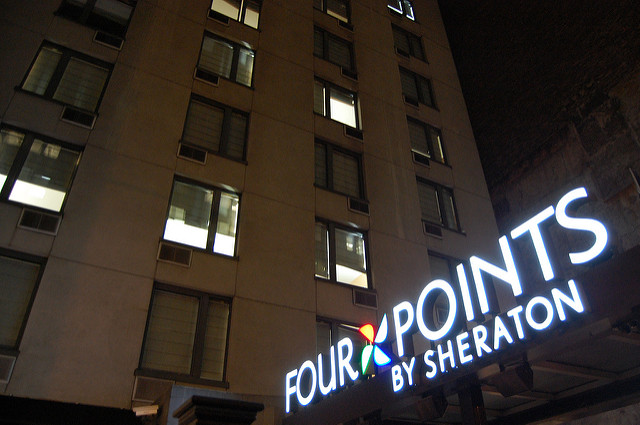
(photo: Andrew Russeth via Flickr)
If you’ve lived in New York City anytime in the last half-century, one thing is as certain as the sun will rise: the rent is just too damn high.
Now, in recent weeks, defenders of the hotel industry would have you believe that this is some new phenomena to be entirely blamed on hardworking home-sharers. How dare they!
I don’t buy it, and neither should you. This is all just part of the hotel industry lobby’s smear campaign, funded by big corporate hotels, like Trump Hotels in New York City. Let’s walk through their mudslinging playbook one step at a time and then talk about the truth.
Step one: Cite a “report” authored by a Canadian researcher and based on unreliable data and offensive racial profiling of hosts -- and most importantly, paid for by the hotel industry lobby -- and pass it off as serious academic research. Falsely claim that New Yorkers sharing their homes are responsible for gentrification.
Step two: Demonize New Yorkers sharing their home so that they can afford to start a business, pay their bills -- and even combat those rising rent prices and stay in their home. Accuse these law-abiding people of gaming the system and operating in secret, and falsely claim that they are the single reason rents are increasing. And go for the shock and awe effect: compare them to President Trump (who, by the way, is a famous hotelier, for anyone looking to make accurate connections).
Step three: Erroneously claim that Airbnb doesn’t share data about listings, hosts, and impact on the local economy. Paint Airbnb and home-sharers as a faceless, opaque, corporate special interest.
Check, check, and check for the hotel lobby.
Over the years, I’ve become skeptical of any front group that will stop at no end to deliberately demonize people and cast blame. It’s a page right out of the Trump playbook - under the chapter titled, “Fake News.”
Because in the case of home-sharing, the truth - the real truth - tells a different story.
The truth is that increasing costs of rent, property taxes, and utilities are resulting in some New Yorkers, particularly in communities of color whose families have lived in their neighborhoods for generations, being pushed out of their homes.
The truth is that, for these New Yorkers under increasing pressure to make ends meet, home-sharing platforms like Airbnb have been a tool of economic empowerment, especially in communities of color. It helps New Yorkers pay for that unexpected doctor’s bill, afford their taxes, fund a new business - and in the case of Airbnb, it’s even helped 79 percent of hosts to stay in their homes. The cost of living is not going down, but in the case of these New Yorkers, home-sharing has ensured that it doesn’t overtake them and their families.
The truth is that home-sharing has helped New Yorkers take control of their economic future. With tourism booming, these new tools have helped expand economic opportunity to New Yorkers, not just hotel owners and others who have traditionally held the wealth and the power in our city.
But here’s the most important truth: if any one party is to shoulder the blame for the declining affordability of our city, it’s the hotel industry that has that dubious honor.
A recent report by the Internet Association found that hotel development (not home sharing) cost the city affordable housing. This report looked at public data, showing that between 2010 and 2016 hotel development “resulted in the loss of more than 750,000 square feet of pre existing residential space and 773 pre existing residential units.”
The hotel industry is all too willing to cast home sharing New Yorkers as the culprits of the affordable housing crisis. But it’s clear that is just a diversion - because when it comes to their big, brand-spanking-new hotel developments, they aren’t putting their money where their mouth is. Consider this truth bomb dropped in that same report:
“If just half of the total new hotel space had been used for residential purposes and 20% of that space was dedicated to affordable housing, more than 2.9 million square feet of market-rate housing and over 727,000 square feet of affordable housing could have been created. That is the equivalent of 3,878 market-rate and 969 affordable one-bedroom units, assuming an average unit size of 750 square feet.”
Next time the hotel industry blames New Yorkers for the affordable housing crisis, ask its representatives how many residential buildings will be converted into housing for visitors. Ask them what new hotel developments will include affordable housing. Ask them why they aren’t partnering with advocacy groups or the city to build new affordable housing. And most importantly, ask why the hotel industry is prosecuting ordinary New Yorkers just trying to make ends meet.
***
Rev. Dr. Johnnie M. Green Jr. ios Senior Pastor, Mount Neboh Baptist Church and President of MPAC.
***
Have an op-ed idea or submission for Gotham Gazette? Email This email address is being protected from spambots. You need JavaScript enabled to view it.
Making the City’s Vacant Land Work for the Public
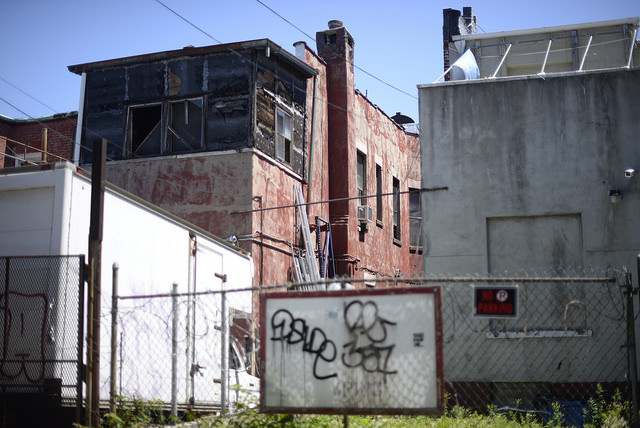
(photo: Sofie Hecht/Gotham Gazette)
Last month, the city’s Department of Housing Preservation and Development (HPD) announced that it selected developers to build affordable housing on 87 city-owned vacant lots, which could produce almost 500 affordable homes. This came the day after Comptroller Scott Stringer released a report criticizing the city for moving slowly on developing such lots.
As New York City staggers through the unrelenting affordable housing, homelessness, and displacement crises this plan is a missed opportunity that we can not tolerate. The city has repeatedly squandered the most value asset - land - it has in fighting these crises. Instead of giving away these vacant lots, the city should keep them and create a public land trust.
New York City owns 1,125 vacant lots. For decades it has relied on an insider-favoring process that turns over vacant properties to private developers and some non-profit developers. That number doesn't include city-owned distressed properties, which is bound to spike as foreclosures are nearing great recession levels. In either case, the transfer comes with laughable requirements for (and definitions of) affordable housing.
This process is the result of a long retreat from the public ambition that defined New York City during its period of great growth in the first half of the 20th century. An activist city government - albeit one tainted by machine politics and systemic racism - built institutions that expanded the very idea of what public life could be and made modern New York City possible. That all ended in the 1970s and left subsequent leaders wary of ambitious public growth and reliant on powerfully connected private actors.
This must change. Our over-reliance on the private market has demonstrably failed the public interest and carries much of the blame for the mess we are in.
Using the community land trust model, the city should retain ownership of the land - removing it from the speculative market that drives up prices - and contract out development based on a fixed equity model that incentivizes construction while limiting costs. It would then directly own and manage this housing stock, guaranteeing that 100% of it is permanently affordable for low- and middle-income households.
Make no mistake, what I am suggesting is public housing. A new, 21st century form that avoids the previous century’s mistakes of massive public housing developments while retaining its public virtues.
Public housing, for all of its problems (thanks to a loss of $1 billion in federal funding since 2000, with more reductions on the way), is still the best vehicle for providing New Yorkers with sustainable affordable housing.
Despite its operational failures, NYCHA currently offers an average monthly rent of $509 to over 400,000 New Yorkers in 176,000 homes and has a waiting list of 257,000 families. Public housing works and we need more of it.
A public land trust that takes advantage of small-site development on vacant lots would work even better as a public housing model in today's economic, political, and social landscape. Instead of the discredited 'shotgun' approach of megablock development that destroyed existing communities while isolating its newly created ones, this approach would be a syringe-sized injection of affordability into existing communities and landscapes.
Neighbors would barely notice the physical changes while enjoying the practical protections of permanent affordability taking root across individual sites. Most of these lots are in distressed neighborhoods that are at high risk of displacement as speculative developers (many of them private equity firms) swoop in. The best, fastest way to address displacement in these neighborhoods is through public-owned land anchoring their development.
The community land trust model works, too. It has successfully provided permanent affordability across the United States for decades, notably in Burlington, Vermont (initially supported by then-mayor Bernie Sanders) and in Dudley Square in Boston (created by local residents who were granted eminent domain). Even here in New York City, the city's first trust, Cooper Square, has quietly managed hundreds of homes in the Lower East Side as a community land trust since 1994.
Speaking of Cooper Square, through its efforts along with the New Economy Project and NYCCLI, the community land trust model has finally started to get the attention it deserves in New York. Last year HPD and Community Enterprises announced $1.65 million in initial funding for the creation of new CLTs and training programs. Many elected officials like then-Borough President Scott Stringer, Council Members Donovan Richards and Margaret Chin, and Attorney General Eric Schneiderman have all worked to expand CLTs in the city.
These developments represent the chance for a fundamental shift in how to create permanent affordable housing in New York City. The land trust model does not rely on excessive tax-subsidies to private developers, flimsy definitions of affordability, or unenforceable protections for maintaining affordability over time. It is simple and sustainable. We should all be excited that the city finally sees this as a viable policy tool.
However, if Mayor de Blasio wants to deliver on his promise to build or protect 300,000 affordable housing units while also recommitting to public housing and NYCHA, he should take the next step by transferring the city’s many vacant lots into a public land trust.
We know the model works. The city knows the model works. Usually the hardest part is acquiring the land, but the city already has it. There is nothing to stop a public land trust from getting into the fight.
New York City was once capable of envisioning and delivering bold progress for the public good. We need this again, updated for the 21st century. The mayor has at the very least claimed this rhetoric and along the way tapped into a respondent audience in many corners of the city. Now it is time to act.
***
Peter Harrison is CEO/Co-founder of homeBody, a public benefit startup. On Twitter @PeteHarrisonNYC.
***
Have an op-ed idea or submission for Gotham Gazette? Email This email address is being protected from spambots. You need JavaScript enabled to view it.
Can the De Blasio Administration Really Register 1.5 Million More Voters?
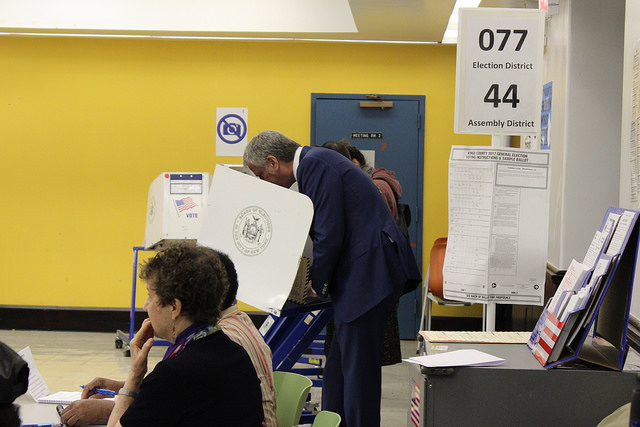
Mayor de Blasio voting (photo: Samar Khurshid/Gotham Gazette)
New York City Mayor Bill de Blasio recently announced a DemocracyNYC plan. One big goal: “to register 1.5 million New Yorkers to vote over the next four years.”
To make this work the mayor will create a new city leadership post: Chief Democracy Officer. How hard will it be for this new chief to meet the mayor’s goal?
Let’s do some rough math, based upon recent enrollment, census, and vital statistics data:
According to estimates in the most recent American Community Survey, there were 5,402,352 citizens of voting age in New York City in 2016 (plus or minus 22,325).
According to the state Board of Elections, in November of 2017 there were 5,053,842 registered voters in the city. That’s 93.5% of the eligible citizens.
Let’s make two initial assumptions to maximize the number of potential additional registrants among those of voting age now to make the CDO’s job more possible. First we’ll put aside reasons for disqualification other than age that would further reduce the number of those eligible but not registered (in prison or on parole for a felony, judged mentally incompetent by a court, voting elsewhere). Second, we’ll add that 22,325 to the estimate – that is, make the high side assumption of the number of age- eligible citizens while remaining within the statistical range of error.
That results in 370,835 citizens who are of voting age now and not registered.
Additionally, there are about 372,000 teenagers in New York City who will reach the age of 18 in the next four years. Of all people in the city over the age of 18, about four in five (80.5%) are citizens. The percentage of citizens among younger people, many born here of immigrant parents, is likely higher. They are not all citizens, but again let’s count more rather than fewer as likely to be eligible to register to vote: 9 in 10 of them. That would be 334,800.
That brings the available target total of potential new registrants to 705,635.
People from elsewhere in the country or living abroad (but not new immigrants) will move into and out of the city during the mayor’s second term. For now let’s just consider those moving in. Some will be children. Some won’t be citizens. A high side assumption from past experience of the number who can be registered: 200,000.
That brings us to 905,635 potential registrants.
Uh oh. We are 594,365 short.
Of course there are all those people who move within the city. They change their addresses. They need to re-register. Maybe the mayor meant to include them; he did not say the Chief Democracy Officer would have to find “new” registrants. So let’s give him the benefit of the doubt. Again we have to watch out for kids, non-citizens, and those already included in our count as not registered. Estimating from federal statistics on people moving annually within and between counties for 2011-2015, it looks like 483,000 is a reasonable number.
Still not there: 1,388,022 (OK, though, we’re getting within shouting distance). To meet the mayor’s goal the Chief Democracy Officer must find about 112,000 more people eligible to register in the next four years, and register them all. Where?
But wait a minute, that’s just the additions. How about the subtractions?
The Empire Center and others have noted that New York City’s population continues to grow every year because immigrants from abroad outnumber the many already living here who are leaving. Less noticed, most of those leaving are voters or vote-eligible, while those who are arriving are non-citizens. A conservative estimate is that 189,000 actual or potential registrants will move out of the city over the next four years.
Finally, there’s mortality. About 212,000 New Yorkers will die during Mayor de Blasio’s second term, more than 95% of whom are voting age. Of course, some - probably a smaller portion than for the city population as a whole - will be non-citizens. A reasonable, conservative estimate is that death will reduce New York City’s potential electorate by 171,000.
One-hundred-eighty-nine thousand plus 171,000 equals 360,000. Departure and mortality will reduce the city’s potential electorate in the next four years by about 6.5%.
Implications:
-Registering 1.5 million people to vote in New York City over the next four years is an impossible dream.
-Registering all of the age-eligible citizens now in the city won’t significantly expand the current electorate; it will keep it about the same size.
-The largest pool of potential registrants during Mayor de Blasio’s second term is comprised of people living in the city who are already registered, but changed their addresses.
-It would be truly extraordinary if the city’s voting roles grew by half-a-million registrants in the next four years.
The bottom line: If I were asked to be the new Chief Democracy Officer, the first thing I’d do is some serious counting. Then I’d call the mayor, to renegotiate the voter registration goal.
***
Gerald Benjamin is Director of The Benjamin Center at SUNY New Paltz.
***
Have an op-ed idea or submission for Gotham Gazette? Email This email address is being protected from spambots. You need JavaScript enabled to view it.




